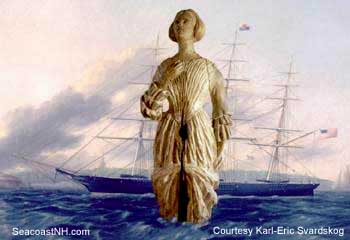|
FRESH STUFF DAILY |
|
|
||
|
|
||
|
|
||
|
SEE ALL SIGNED BOOKS by J. Dennis Robinson click here |
||
Page 2 of 4
The Clipper Ship Nightingale In 1851, the same year Jenny Lind arrived in Boston, the Nightingale (originally named Sarah Cowles) left its berth place in Eliot, Maine. It was towed up the Piscataqua River to Boston, Mass.. Owners planned to use the fast, sleek clipper to whisk 50 first-class passengers ($125 round trip) to the London World's Fair that season. The idea fell through. In Boston the carved figurehead of a woman resembling the Swedish Nightingale, Jenny Lind was added. At least, that's what Karl-Eric Svardskog believes. The Nightingale traveled around the world at record speeds, but finding enough passengers who could afford the rapid transit clipper proved difficult. Passengers were replaced by cargo, as a series of new owners struggled to make the ship profitable. One owner transformed the ship into a slaver since it could outrun the English and American authorities. 960 enslaved Africans were crowded into a ship built for 50 wealthy tourists. Another Portsmouth-built ship, the Saratoga, was instrumental in capturing the Nightingale. The passengers were freed, but horribly, nearly 200 had died of illness, starvation and abuse. Sold to owner after owner, the Nightingale was for a time the property of the United States Navy and used to haul coal. Once among the world's fastest clippers, Nightingale was reduced to transporting lumber when it was finally abandoned off Norway in 1894. By this time both PT Barnum and Jenny Lind were dead. Lind died in 1887 after a long self-imposed retirement. Wealthy and isolated, her 1850s whirlwind tour of America turned out to be her last. The Scarecrow in the Barn Fast forward to 1994. That's the year antiques hunter Svardskog heard about the large wooden carving shaped like a woman that a Swedish family once used as a scarecrow. He found it in a hayloft, one arm sticking out of the hay, where it had apparently lain for a century. Compelled to track down the origin of the life-sized ship's figurehead, Svardskog searched six years for clues to its origin. He traced the carving to Boston artist John Mason and matched it to publicity pictures of the famous Swedish soprano. Of the four ships named in honor of Lind, only the Portsmouth-area clipper matched the timeline necessary to validate Svardskog's theory. But didn't that Nightingale sink off the coast of Norway in 1894? In his research, Svardskog discovered that the Nightingale had actually been in the vicinity of the town where the figurehead was discovered. In 1874, workers had refit the ship in Norway nearby. The bow of the ship was damaged on a reef off the coast of Kargero. Svardskog theorizes that the Jenny Lind figurehead was removed during the repair work, and did not go down with the ship years later. The original boathouse of the Nightingale, removed during repair, is still at the repair yard in Norway. Transporting the heavy carving to Sweden was possible, he says, because there was a railroad line that once ran between the shipyard and the farm where the "scarecrow" was found. Was Svardskog right, or simply bending facts to fit his theory? CONTINUE Nightingale Figurehead Please visit these SeacoastNH.com ad partners.
News about Portsmouth from Fosters.com |
| Thursday, April 25, 2024 |


|
Copyright ® 1996-2020 SeacoastNH.com. All rights reserved. Privacy Statement
Site maintained by ad-cetera graphics

 HISTORY
HISTORY



















